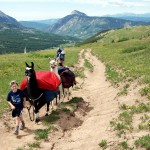Bison, UFO’s, and Skiing on Sand
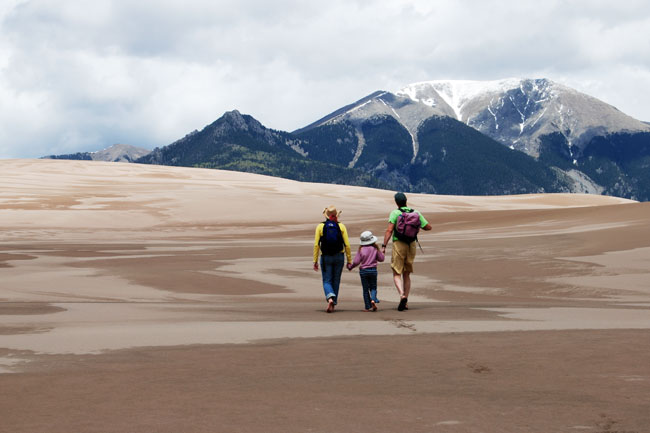
Hiking along the surreal landscape of the Great Sand Dunes.
The pile of gear laid out in our garage was incongruous: sand shovels and pails, skis, sun hats, a snow sled. We were packing for a trip to Great Sand Dunes National Park and Preserve in southern Colorado. Tucked in the curve where the Sangre de Cristo range meets the San Luis Valley, 30 square miles of sand pile up in dunes as high as 750 feet. On the drive toward the park along the flat expanse of the valley, the dunes materialize unexpectedly, as if someone had superimposed the Sahara onto Colorado’s lush, blue-green mountains.
Last month my husband, Jeff, and I, along with our three small children, hiked through the sand sheet, the vegetated stretch of sand surrounding the dunes. In the distance a fuzzy-antlered elk nibbled on Indian rice grass. Yucca and prickly pear cactus lined the trail, which led us to the base of the dunes. The children cooked sand cakes and lay down to make sand angels. They dug until they hit water, then jumped into the mucky pit, barefoot and giggling.

Jeff snowboarding on sand. Requisite gear: a wide-brimmed sun hat.
Wind, water and the geography of the San Luis Valley created the dunes. The San Juans thrust up on the western edge of the broad basin, and the Sangre de Cristos flank the eastern edge. Since the last ice age, eroded minerals from the mountains, mostly the San Juans, and sediment from dried-up lakes blew into the giant sand trap of the Sangre de Cristos. Today the dunes are constantly recycling as snowmelt fuels seasonal creeks that carry sand downstream. Southwesterly winds then blow it back to the dunes, and northeasterly winds help sculpture a frothy meringue of peaks, valleys and ridgelines.
Our campsite was set in a stand of 700-year-old junipers overlooking the dune field. The first night in the tent, the wind howled, and we imagined the sand swirling on the dunes, erasing the feathery pattern of handprints we’d left. The next morning we headed to the main dune parking lot and trudged to High Dune, a 1.1-mile slog through soft sand. We were not alone. On any given summer day, a hundred visitors make the hike. We passed people flying kites, a man snowboarding in sneakers and college guys doing flips off ridge lines.
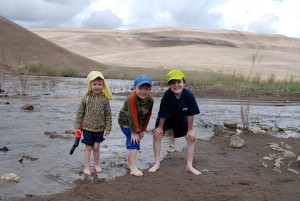
Playing in Medano Creek at the base of the sand dunes.
Walking uphill in the dunes is a Sisyphean endeavor: take one step forward, fall half a step back. But the panorama at the top was worth it. The dunes appear like a gigantic, rumpled bedspread. What looks uniformly beige from a distance is really a multitude of shades. Waves of white sand rippled through sheets of gold. Up high, we found swirls of black magnetite, a mineral that can spin the needle on a compass.
On another morning we set out to find Medano Creek and slopes for skiing. We drove a mile down the sandy Medano Pass road, parking at the Point of No Return. Every week in a dry summer, several cars get mired in the deep sand on the next section of road. Instead of driving, we hitched a ride in a 1979 International Harvester Scout with Dale Mark, a dunes regular in a pith helmet and aviator sunglasses. He directed us to Castle Creek for the best skiing, tipping his hand near vertical to indicate the pitch. I strapped my skis and ski boots onto a pack and headed uphill.
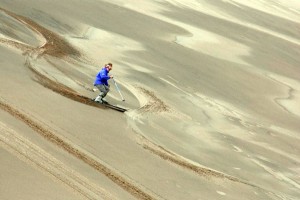
Leaving tracks in sand means skiing in super slow-mo.
Photo credit: William Rogers
Though it was still early, the heat of the sand burned through my hiking boots. By summer afternoons, surface temperatures can reach 150 degrees. Sweating, I hiked past clusters of prairie sunflowers growing defiantly in the swales. The sand cracked and hummed underfoot.
When it comes to sliding, the salient difference between snow and sand is friction. Even on the 34-degree pitch — the angle of repose for sand here — I was barely moving. I made a dozen slow-motion turns down the 300-foot face, setting off sand avalanches around my feet. “Wet sand would be way faster,” Mr. Mark said.
Water was the driving force behind the Great Sand Dunes’ becoming the country’s newest national park. In the 1920s people here began lobbying to protect the dunes from gold mining. In 1932 Herbert Hoover established 38,000 acres of dunes as a national monument. Decades later, as researchers began to understand better the integral role of water to the dune system, the threat of commercial water development made it critical to protect not just the dunes but also the surrounding creeks and wetlands — and the massive aquifer beneath the dunes. In 2004 the boundaries were expanded to cover 150,000 acres, and the area was designated as a national park and preserve.
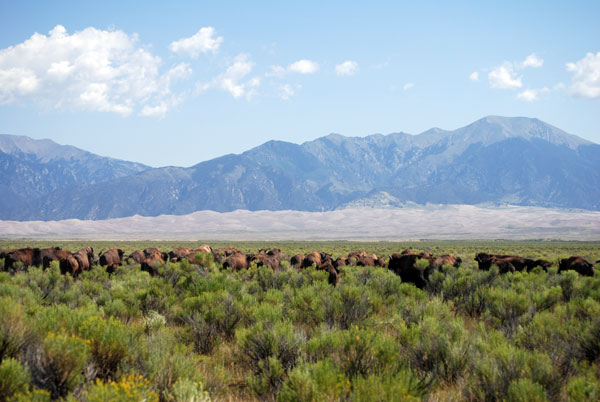
A scene in layers: sage brush, bison, great mounts of sand, and the Sangre de Cristo mountains.
Just outside the park, the Nature Conservancy manages a preserve of another sort: a herd of 2,000 American bison that roam on the 103,000-acre Zapata Ranch. The kids were eager to see the beasts. At the ranch, we piled into a creaking wooden wagon pulled by a Suburban to scout for bison. Bumping along a dusty, rutted road through yellow rabbit brush, we came upon a group of 75 or so. On the horizon we could see hundreds more. With the dunes as a bizarre backdrop, the bison rolled in the dust, nuzzled their rust-colored calves and gave us the opportunity to explain “hanky-panky” to the children.
The children learned other, somewhat more wholesome, things on the trip. At a kids’ talk, the park ranger asked, “How do you think a kangaroo rat pees?” The answer: “It doesn’t!” The kangaroo rat, the only mammal that spends its entire life in the dunes, conserves water by excreting crystals.
To escape the afternoon heat, we hiked to Zapata Falls just south of the park. After a half-mile, we walked through ankle-chilling water to the falls, a 30-foot surge of water squirting through the rocks. The spray cooled us instantaneously. Back at the campsite, we watched shadows grow long on the dunes, creating dark crescents on the light sand. The sun set in shades of pink, purple and orange as hikers moved along ridge tops like tiny commas.

“Okay, so we’re holding a real live gator. This is some seriously questionable parenting.”
As if the dunes themselves weren’t trippy enough, we toured the nearby Colorado Gators, where some 400 alligators wriggle in ponds heated by a geothermal well. The tilapia farmers here originally introduced alligators as garbage disposals for fish carcasses, but they soon became a tourist attraction. The farm also houses a menagerie of exotic reptiles, including an albino Burmese python. The kids held an alligator, receiving a “Certificate of Bravery,” which was then ceremoniously chomped like a hole-puncher by said gator.
Stranger yet, we stopped by the UFO Watchtower, just down the road in Hooper, Colorado. A former cattle rancher, Judy Messoline has erected a metal observation deck around a monolithic dome. We climbed up and scanned the skies, to no avail. Out front, there’s a gravel “Healing Garden” that, according to Ms. Messoline, contains two spinning vortexes: portals to a parallel universe. Hundreds of items left by visitors as offerings litter the garden: a Snow White Pez dispenser, a BlackBerry, a pair of fuzzy dice.
Before heading home, we hiked the park’s Montville Nature Trail, which winds through gnarled pinon pines. Red fairy trumpets lined the trail, and beads of rain on the aspen leaves sparkled like diamonds in the sun. We caught views of the dunes framed by weathered snags. Even after a week, the hills of sand continued to surprise. “They are just so strange,” my husband said. Again.
Then the weirdness ratcheted up yet another notch: Our six-year-old reported he’d seen a U.F.O. “It was a big, orange fiery ball,” he said. “I think it was a … a flying saucer. I definitely saw something.”

Wild skies at the Great Sand Dune.
IF YOU GO
The park is about 240 miles south of Denver, and 175 miles north of Santa Fe, N.M. Park information is at nps.gov/GRSA/index.htm.
WHERE TO STAY
The Pinyon Flats campground has 88 first-come, first-served sites inside the park ($14 per night) . On summer weekends, the campground fills nightly, so arrive early. There are also 25 free backcountry sites along Medano Pass road, which requires a high-clearance four-wheel-drive vehicle. With a permit from the visitor center, you can backpack on the dunes themselves. Just outside the park at Great Sand Dunes Lodge (7900 Highway 150; 719-378-2900, gsdlodge.com), motel rooms start at $89. Next door, Great Sand Dunes Oasis (5400 Highway 150; 719-378-2222, greatdunes.com) has a grocery, gas station, cabins, and camping. Tent sites are $18 a night for two.
WHERE TO EAT
Bring the Coleman stove for eggs, pancakes and bacon alfresco. Pinyon Flats campsites have fire pits with grills for hot dogs and burgers. The café at the Oasis serves all day.
WHAT TO DO
Bring a snow sled, old skis and a snowboard for sand sliding. In summer, start early to hike the dunes. Follow the throngs to High Dune or for solitude, drive the Medano Pass road to the Sand Pit or Castle Creek areas. Pack sand toys for building castles and bathing suits for splashing in Medano Creek.
The turnoff for Zapata Falls (nps.gov/archive/grsa/zapata_falls.htm) is 10 miles south of the park on Highway 150. The trailhead is 3.5 miles up a dirt road. Reserve ahead for a bison tour with Zapata Ranch (888-592-7282, zranch.org). Tours run two to three hours; the cost is $50 for adults; $25, 12 and under; 5-and-unders are free.
A no-trespassing sign at Colorado Gators (719-378-2612, gatorfarm.com) warns “Violators May Be Eaten.” From the Sand Dunes, the farm is a 20-mile drive, west on Lane 6, north on route 17. Admission is $12.50 for adults; $6.25 for ages 6-15. The UFO Watchtower (ufowatchtower.com) is just north, in Hooper, Colo. Although the San Luis Valley is a reputed hot spot for sighting alien spacecraft, the $5 admission comes with no guarantee.
A version of this story appeared in The New York Times in October 2009.


